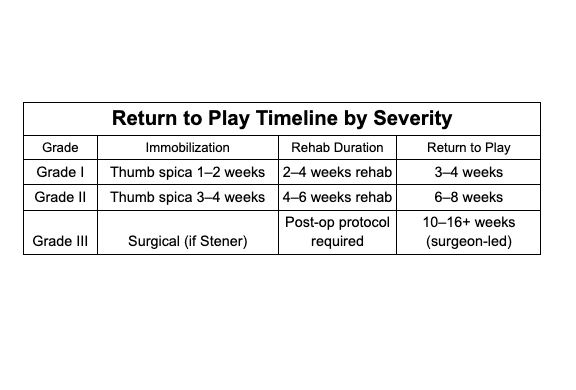Thumb UCL Sprain
The ulnar collateral ligament (UCL) of the thumb is critical for grip, catching, and throwing. In catchers, repetitive ball impact, awkward glove positioning, a jammed thumb on a foul ball or tag play can sprain or tear this ligament.
If not managed properly, thumb UCL injuries can lead to chronic instability, poor grip, and prolonged time out of play.
What Is a Thumb UCL Sprain?
The UCL of the thumb stabilizes the metacarpophalangeal (MCP) joint against valgus stress (thumb pulling away from hand).
A sprain happens when:
- The thumb is hyperabducted or hyperextended (glove jam, tag collision)
- Chronic microtrauma weakens the ligament over time
- Mechanism of Injury (Catchers)
- Traumatic valgus stress: Jammed thumb during glove impact or tagging
- Hyperextension injury: Thumb forced back when blocking or catching
- Repetitive microtrauma: Chronic stress from glove work and repetitive catching loads
Clinical Presentation
Grade I (Mild):
- Ligament stretched but intact
- Local pain/swelling at MCP joint
- No instability, firm endpoint with valgus stress
- Mild grip weakness
Grade II (Moderate):
- Partial tear
- 15–20° laxity vs. opposite side → suspect tear
- Pain and swelling along UCL
- Laxity with firm endpoint on valgus stress
- Pain gripping bat, ball, or glove
Grade III (Severe):
- Complete tear ± Stener lesion (ligament displaced above adductor aponeurosis)
- 30° or absent endpoint → complete tear = surgical referral
- Gross laxity with no firm endpoint
- Severe weakness gripping or pinching
- Often surgical
Imaging
- X-ray: Rule out avulsion fracture at UCL insertion
- MRI: Best for partial vs complete tear and Stener lesion identification
- Clinical valgus stress test: Compare bilaterally for laxity
Non-Operative Rehab Protocol (Grade I–II Only)
Phase 1: Acute Protection (Weeks 0–2)
Goal: Protect ligament, reduce pain/swellingImmobilization: Thumb spica brace or splint (MCP joint stabilized, IP free)
- Ice + compression
- No catching or gripping drills
- Gentle pain-free ROM of uninvolved fingers and wrist
Phase 2: Controlled Motion (Weeks 2–4)
Goal: Restore pain-free ROM and initiate light strengthening
- Remove brace for controlled thumb flexion/extension (avoid valgus stress)
- Begin isometric thumb flexion/adduction (press thumb gently into index)
- Gentle wrist and grip strengthening (squeeze ball/putty without thumb pain)
- Light glove drills (non-throwing, controlled receives only) in brace
Phase 3: Strengthening & Functional Training (Weeks 4–6)
Goal: Improve stability, grip strength, and functional catching
- Thumb UCL loading: resisted adduction (rubber band or therapist)
- Pinch grip drills: thumb-to-finger opposition, isometric pinches
- Glove handling drills: progressive catch & block while braced
- Continue wrist, forearm, and grip strengthening
- Laser therapy: 6–8 J/cm² over UCL region to support ligament healing
Phase 4: Return-to-Play Integration (Weeks 6–8+)
Goals: Full thumb stability and pain-free catching/throwing
- Wean brace for light fielding and throwing
- Sport-specific drills:
- Catch-block-transfer sequences
- Receiving high-velocity pitches
- Batting grip tolerance
- Ensure valgus stability: test MCP with valgus stress at 0° and 30° flexion
- Begin full catching load once pain-free and stable
Return to Play Timeline

Return-to-Play Checklist
- Full thumb MCP ROM pain-free
- Grip strength ≥ 90–95% of opposite hand
- Negative valgus stress test (firm endpoint)
- Pain-free glove use and blocking
- Pain-free batting grip and transfers
References
1. Campbell CS et al. (2020). Thumb UCL injuries in athletes: Diagnosis and management. J Hand Surg Am.
2. Rettig AC. (2004). Thumb collateral ligament injuries in sports. Am J Sports Med.
3. Wilk KE et al. (2015). Rehabilitation of hand and thumb injuries in athletes. Sports Health.
4. Lee AT et al. (2019). Return-to-play after thumb UCL injuries in professional baseball. Orthop J Sports Med.
5. Mohseni M, Sina RE, Graham C. Ulnar Collateral Ligament Injury (Gamekeeper’s Thumb). StatPearls [Updated Feb 1, 2024].
